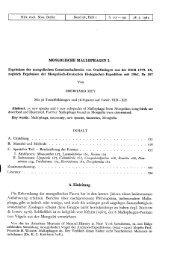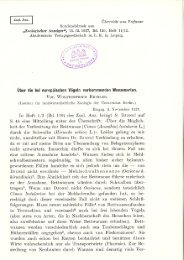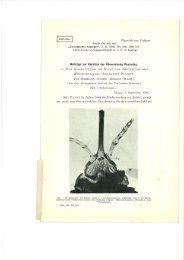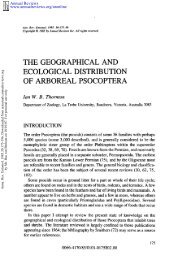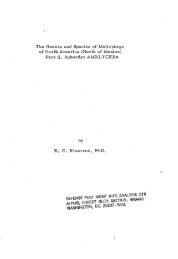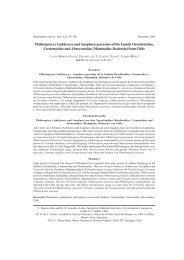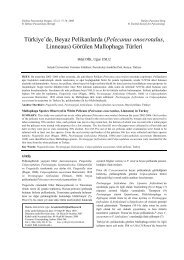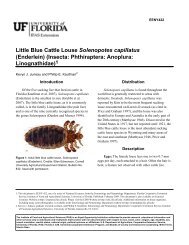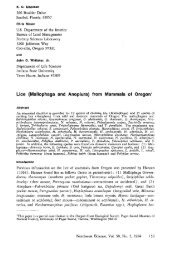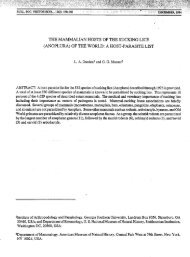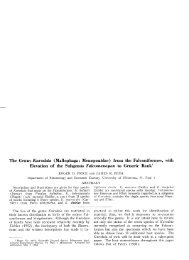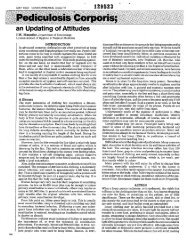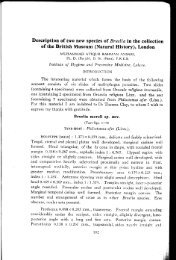The population dynamics and host utilization of ... - Phthiraptera
The population dynamics and host utilization of ... - Phthiraptera
The population dynamics and host utilization of ... - Phthiraptera
Create successful ePaper yourself
Turn your PDF publications into a flip-book with our unique Google optimized e-Paper software.
296 R.W. Rust<br />
Table 1. Recovery <strong>of</strong> Geomydoecus oregonus from gophers, each artificially infested<br />
with newly hatched first instar nymphs. Gophers maintained in artificial burrows<br />
Days Inoc- I~umber <strong>and</strong> stage <strong>of</strong> development Total %<br />
after ulum Mortality<br />
infesta- Immatures Adults<br />
tion 1st 2nd 3rd ~<br />
6 36 18 . . . . 18 50.0<br />
10 58 1 16 -- -- -- 17 70.3<br />
15 49 -- 8 1 -- -- 9 81.7<br />
20 32 -- 2 2 -- -- 4 87.5<br />
25 31 -- -- 2 -- -- 2 93.5<br />
30 40 -- -- -- 2 1 3 90.0<br />
the lice <strong>and</strong> a delay (12 h) before they could feed or assume a correct<br />
posture on the gopher. <strong>The</strong> results (Table 2) obtained from cohorts<br />
starting with the egg stage, indicate a Type II survivorship curve for the<br />
louse <strong>population</strong>. Thus, age frequency mortalities can be calculated as<br />
0.02 for eggs, 0.18, 0.24, <strong>and</strong> 0.06 for the nymphal instars, <strong>and</strong> 0.50 for<br />
adult lice. Due to the 10 day age difference <strong>of</strong> eggs used to initiate these<br />
tests, females <strong>and</strong> new eggs were already present on the gophers in the<br />
30 day samples, <strong>and</strong> at 40 days, new first instar lice appeared in the<br />
samples. Using the pivotal frequency for reproductives, it is possible to<br />
estimate the net reproductive rate, Ro=Zlxm x. Thus, R o for G. oregonus<br />
is 1.272 (0.53 X 2.4= 1.272). This assumes a 1:1.2 sex ratio, equal survival<br />
<strong>of</strong> sexes <strong>and</strong> an average <strong>of</strong> 4 eggs per female louse. <strong>The</strong> intrinsic rate <strong>of</strong><br />
increase (r) can be calculated from Ro=e% Thus, r is equal to 0.24 per<br />
generation or 0.006 per day, <strong>and</strong> the <strong>population</strong> doubles in 2.8 genera-<br />
tions.<br />
Duration<br />
days<br />
Table 2. Recovery <strong>of</strong> Geomydoecu8 oregonus from gophers, each naturally infested<br />
with eggs. Gophers maintained in artificial burrow systems<br />
Num- Inoc- Number <strong>and</strong> stage <strong>of</strong> development Mortality<br />
ber<br />
<strong>of</strong><br />
ulum<br />
eggs Immatures Adults Eggs % %<br />
gophers eggs total<br />
1st 2nd 3rd ~ !~ Unhatched new<br />
%a<br />
age<br />
interval<br />
20<br />
30<br />
40<br />
2 295 65 127 34 7 -- 2.3 20.0<br />
4 551 -- 7 187 42 43 11 21 1.9 49.4<br />
5 914 13 b -- 30 150 180 ? 157 ? 60.7<br />
a Determined initially from 2 % egg mortality <strong>and</strong> rounded to nearest whole number.<br />
b First instars <strong>of</strong> second generation.<br />
18.0<br />
30.0<br />
ll.0



